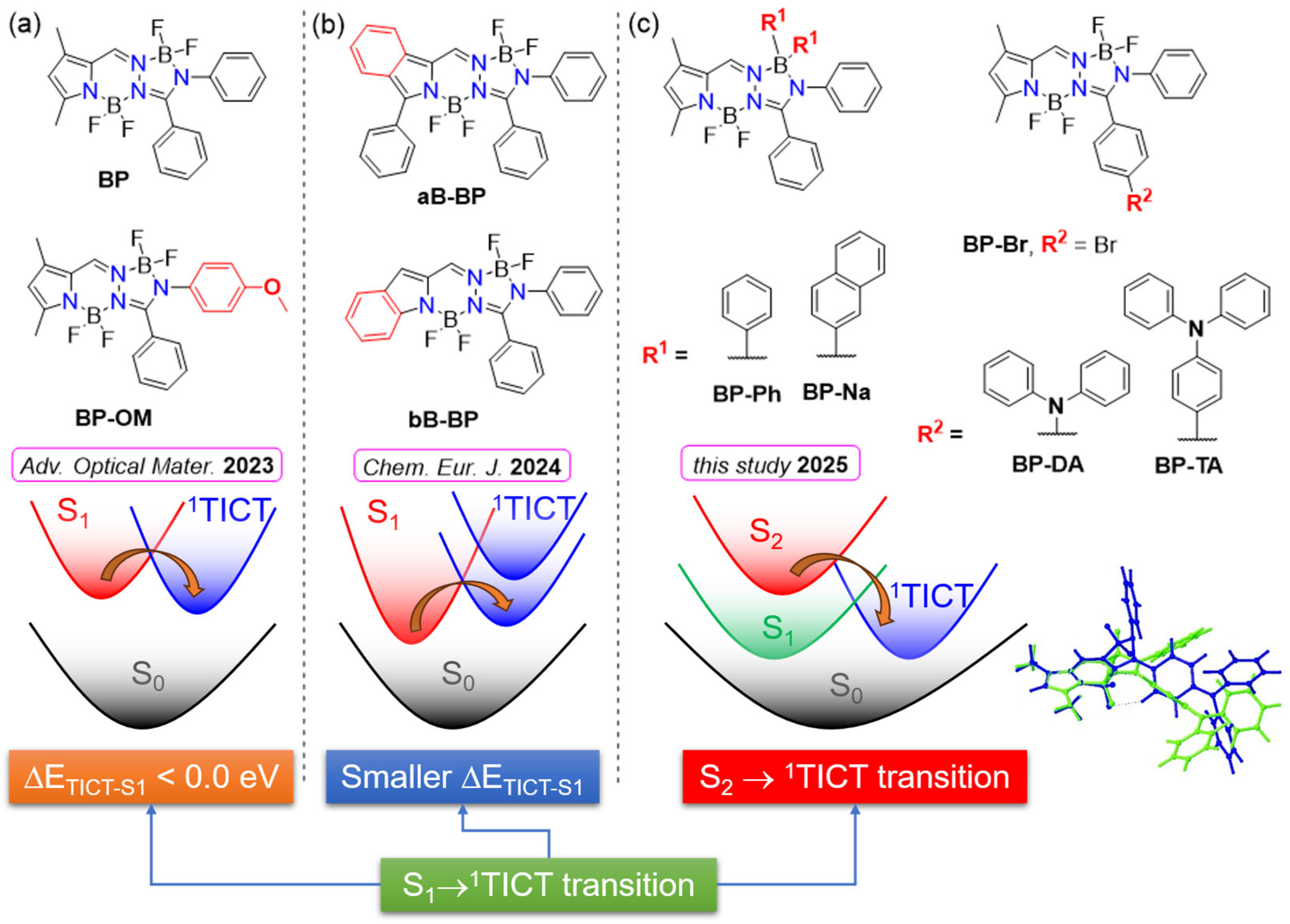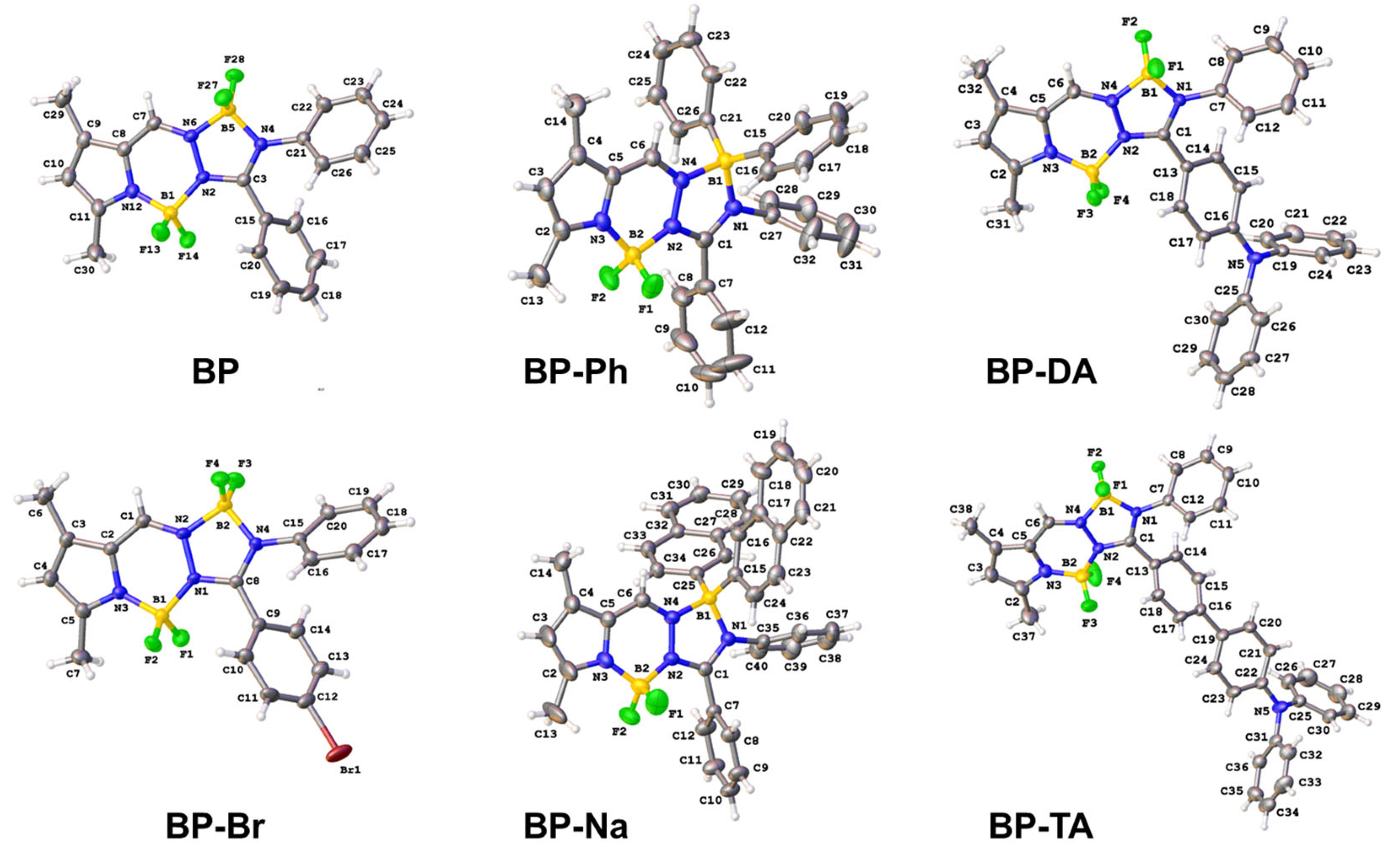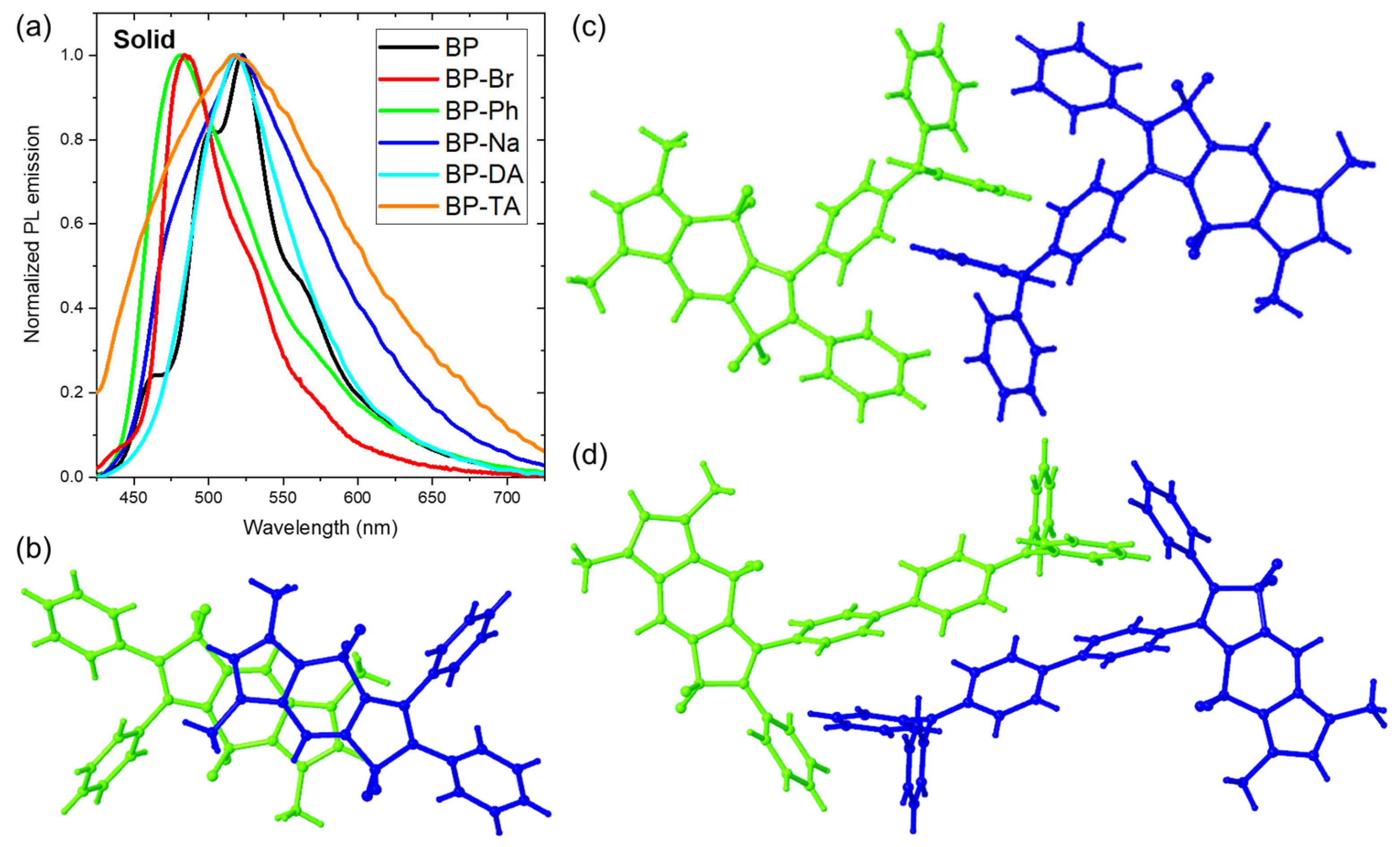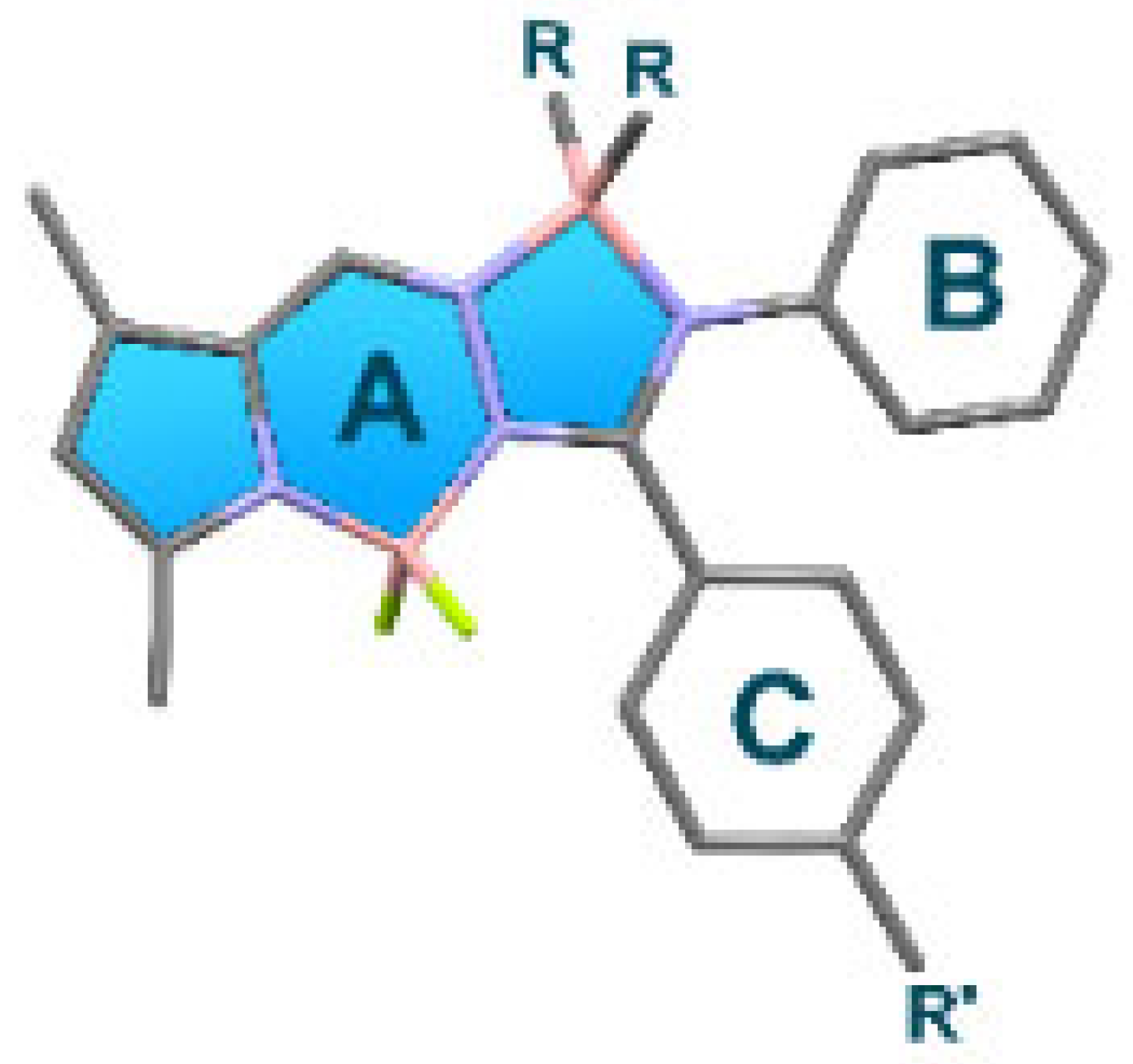BOPAM’s Bright and Dark Excited States: Insight from Structural, Photophysical, and Quantum Chemical Investigations
Abstract
1. Introduction
2. Results and Discussion
2.1. Synthesis
2.2. Structural Characterization by SC-XRD
2.3. UV–Vis Absorption and Emission Properties

2.4. The Presence of a Dark State
2.5. Revisiting the Excited State Decay of BOPAMs
2.6. Solid State Spectra
3. Materials and Methods
3.1. General Synthesis of BOPAM
3.2. Computational Details
4. Conclusions
Supplementary Materials
Author Contributions
Funding
Institutional Review Board Statement
Informed Consent Statement
Data Availability Statement
Acknowledgments
Conflicts of Interest
References
- Fan, Y.; Wu, Y.; Hou, J.; Wang, P.; Peng, X.; Ge, G. Coumarin-based near-infrared fluorogenic probes: Recent advances, challenges and future perspectives. Coord. Chem. Rev. 2023, 480, 215020. [Google Scholar] [CrossRef]
- Meares, A.; Satraitis, A.; Santhanam, N.; Yu, Z.; Ptaszek, M. Deep-Red Emissive BODIPY–Chlorin Arrays Excitable with Green and Red Wavelengths. J. Org. Chem. 2015, 80, 3858–3869. [Google Scholar] [CrossRef]
- Frath, D.; Massue, J.; Ulrich, G.; Ziessel, R. Luminescent materials: Locking pi-conjugated and heterocyclic ligands with boron (III). Angew. Chem. Int. Ed. Engl. 2014, 53, 2290–2310. [Google Scholar] [CrossRef]
- Mendive-Tapia, L.; Zhao, C.; Akram, A.R.; Preciado, S.; Albericio, F.; Lee, M.; Serrels, A.; Kielland, N.; Read, N.D.; Lavilla, R.; et al. Spacer-free BODIPY fluorogens in antimicrobial peptides for direct imaging of fungal infection in human tissue. Nat. Commun. 2016, 7, 10940. [Google Scholar] [CrossRef]
- Yuan, L.; Lin, W.; Zheng, K.; He, L.; Huang, W. Far-red to near infrared analyte-responsive fluorescent probes based on organic fluorophore platforms for fluorescence imaging. Chem. Soc. Rev. 2013, 42, 622–661. [Google Scholar] [CrossRef] [PubMed]
- Saito, S.; Matsuo, K.; Yamaguchi, S. Polycyclic π-Electron System with Boron at Its Center. J. Am. Chem. Soc. 2012, 134, 9130–9133. [Google Scholar] [CrossRef]
- Treibs, A.; Kreuzer, F.-H. Difluorboryl-Komplexe von Di- und Tripyrrylmethenen. Justus Liebigs Ann. Chem. 1968, 718, 208–223. [Google Scholar] [CrossRef]
- Tamgho, I.-S.; Hasheminasab, A.; Engle, J.T.; Nemykin, V.N.; Ziegler, C.J. A New Highly Fluorescent and Symmetric Pyrrole–BF2 Chromophore: BOPHY. J. Am. Chem. Soc. 2014, 136, 5623–5626. [Google Scholar] [CrossRef] [PubMed]
- Yu, C.; Fang, X.; Wu, Q.; Jiao, L.; Sun, L.; Li, Z.; So, P.-K.; Wong, W.-Y.; Hao, E. A Family of BODIPY-like Highly Fluorescent and Unsymmetrical Bis(BF2) Pyrrolyl–Acylhydrazone Chromophores: BOAPY. Org. Lett. 2020, 22, 4588–4592. [Google Scholar] [CrossRef]
- Pookkandam Parambil, S.; de Jong, F.; Veys, K.; Huang, J.; Veettil, S.P.; Verhaeghe, D.; Van Meervelt, L.; Escudero, D.; Van der Auweraer, M.; Dehaen, W. BOPAHY: A doubly chelated highly fluorescent pyrrole–acyl hydrazone –BF2 chromophore. Chem. Commun. 2020, 56, 5791–5794. [Google Scholar] [CrossRef]
- Boens, N.; Verbelen, B.; Ortiz, M.J.; Jiao, L.; Dehaen, W. Synthesis of BODIPY dyes through postfunctionalization of the boron dipyrromethene core. Coord. Chem. Rev. 2019, 399, 213024. [Google Scholar] [CrossRef]
- Lu, H.; Mack, J.; Yang, Y.; Shen, Z. Structural modification strategies for the rational design of red/NIR region BODIPYs. Chem. Soc. Rev. 2014, 43, 4778–4823. [Google Scholar] [CrossRef] [PubMed]
- Chong, H.; Fron, E.; Liu, Z.; Boodts, S.; Thomas, J.; Harvey, J.N.; Hofkens, J.; Dehaen, W.; Van der Auweraer, M.; Smet, M. Acid-Sensitive BODIPY Dyes: Synthesis through Pd-Catalyzed Direct C(sp3)−H Arylation and Photophysics. Chem.—Eur. J. 2017, 23, 4687–4699. [Google Scholar] [CrossRef]
- Rohand, T.; Qin, W.; Boens, N.; Dehaen, W. Palladium-Catalyzed Coupling Reactions for the Functionalization of BODIPY Dyes with Fluorescence Spanning the Visible Spectrum. Eur. J. Org. Chem. 2006, 2006, 4658–4663. [Google Scholar] [CrossRef]
- Bumagina, N.A.; Antina, E.V.; Ksenofontov, A.A.; Antina, L.A.; Kalyagin, A.A.; Berezin, M.B. Basic structural modifications for improving the practical properties of BODIPY. Coord. Chem. Rev. 2022, 469, 214684. [Google Scholar] [CrossRef]
- Boens, N.; Verbelen, B.; Dehaen, W. Postfunctionalization of the BODIPY Core: Synthesis and Spectroscopy. Eur. J. Org. Chem. 2015, 2015, 6577–6595. [Google Scholar] [CrossRef]
- Peterson, J.A.; Wijesooriya, C.; Gehrmann, E.J.; Mahoney, K.M.; Goswami, P.P.; Albright, T.R.; Syed, A.; Dutton, A.S.; Smith, E.A.; Winter, A.H. Family of BODIPY Photocages Cleaved by Single Photons of Visible/Near-Infrared Light. J. Am. Chem. Soc. 2018, 140, 7343–7346. [Google Scholar] [CrossRef]
- Slanina, T.; Shrestha, P.; Palao, E.; Kand, D.; Peterson, J.A.; Dutton, A.S.; Rubinstein, N.; Weinstain, R.; Winter, A.H.; Klán, P. In Search of the Perfect Photocage: Structure–Reactivity Relationships in meso-Methyl BODIPY Photoremovable Protecting Groups. J. Am. Chem. Soc. 2017, 139, 15168–15175. [Google Scholar] [CrossRef] [PubMed]
- Ksenofontov, A.A.; Bocharov, P.S.; Ksenofontova, K.V.; Antina, E.V. Water-Soluble BODIPY-Based fluorescent probe for BSA and HSA detection. J. Mol. Liq. 2022, 345, 117031. [Google Scholar] [CrossRef]
- Huang, J.; de Jong, F.; Elisa van Raamsdonk, D.M.; Vandenwijngaerden, J.; Inoue, A.; Escudero, D.; Van Meervelt, L.; Van der Auweraer, M.; Dehaen, W. BOPAM: Efficient Synthesis of a Bright Asymmetric Bis-Boron Complex and its Dark Side. Adv. Opt. Mater. 2024, 12, 2301328. [Google Scholar] [CrossRef]
- Huang, J.; Chung Pham, T.; Coenen, D.; Vandenwijngaerden, J.; Gong, J.; Minh Thi Nguyen, H.; Van Meervelt, L.; Van der Auweraer, M.; Escudero, D.; Dehaen, W. Benzo-Fused BOPAM Fluorophores: Synthesis, Post-functionalization, Photophysical Properties and Acid sensing Applications. Chem. Eur. J. 2024, 30, e202401837. [Google Scholar] [CrossRef]
- Ulrich, G.; Goze, C.; Guardigli, M.; Roda, A.; Ziessel, R. Pyrromethene Dialkynyl Borane Complexes for “Cascatelle” Energy Transfer and Protein Labeling. Angew. Chem. Int. Ed. 2005, 44, 3694–3698. [Google Scholar] [CrossRef]
- Goze, C.; Ulrich, G.; Mallon, L.J.; Allen, B.D.; Harriman, A.; Ziessel, R. Synthesis and Photophysical Properties of Borondipyrromethene Dyes Bearing Aryl Substituents at the Boron Center. J. Am. Chem. Soc. 2006, 128, 10231–10239. [Google Scholar] [CrossRef]
- Choi, S.H.; Pang, K.; Kim, K.; Churchill, D.G. Cu2+ Colorimetric Sensing and Fluorescence Enhancement and Hg2+ Fluorescence Diminution in “Scorpionate”-like Tetrathienyl-Substituted Boron–Dipyrrins. Inorg. Chem. 2007, 46, 10564–10577. [Google Scholar] [CrossRef] [PubMed]
- Qin, W.; Rohand, T.; Baruah, M.; Stefan, A.; der Auweraer, M.V.; Dehaen, W.; Boens, N. Solvent-dependent photophysical properties of borondipyrromethene dyes in solution. Chem. Phys. Lett. 2006, 420, 562–568. [Google Scholar] [CrossRef]
- Qin, W.; Baruah, M.; Van der Auweraer, M.; De Schryver, F.C.; Boens, N. Photophysical Properties of Borondipyrromethene Analogues in Solution. J. Phys. Chem. A 2005, 109, 7371–7384. [Google Scholar] [CrossRef] [PubMed]
- Veys, K.; de Jong, F.; Adriaens, A.; Coenen, G.; Coenen, K.; De Ligt, Y.; Meysman, Q.; Paredis, T.; Stalmans, J.; Dehaen, W.; et al. Revisiting the Fluorescence of Benzothiadiazole Derivatives: Anti-Kasha Emission or Not? ChemPhotoChem 2023, 7, e202200262. [Google Scholar] [CrossRef]
- Veys, K.; Escudero, D. Anti-Kasha Fluorescence in Molecular Entities: Central Role of Electron–Vibrational Coupling. Acc. Chem. Res. 2022, 55, 2698–2707. [Google Scholar] [CrossRef]
- Kasha, M. Energy Transfer Mechanisms and the Molecular Exciton Model for Molecular Aggregates. Radiat. Res. 1963, 20, 55–70. [Google Scholar] [CrossRef]
- Szabo, A.; Ostlund, N.S. Modern Quantum Chemistry: Introduction to Advanced Electronic Structure Theory; Dover Publications: Mineola, NY, USA, 1996. [Google Scholar]
- Deshmukh, A.P.; Geue, N.; Bradbury, N.C.; Atallah, T.L.; Chuang, C.; Pengshung, M.; Cao, J.; Sletten, E.M.; Neuhauser, D.; Caram, J.R. Bridging the gap between H- and J-aggregates: Classification and supramolecular tunability for excitonic band structures in two-dimensional molecular aggregates. Chem. Phys. Rev. 2022, 3, 021401. [Google Scholar] [CrossRef]
- Kuhn, H.; Kuhn, C. Chromophore coupling effects. In J-Aggregates; World Scientific: Singapore, 1996; pp. 1–40. [Google Scholar]
- Spano, F.C. Vibronic coupling in J-aggregates. In J-Aggregates; World Scientific: Singapore, 2012; pp. 49–75. [Google Scholar]
- Li, L.; Ouyang, H.; Long, Z.; Zhang, Q.; Jiang, Y.; Cai, M.; Xiong, S.; Peng, S.; Xu, G.; He, Q. A triphenylamine-based fluorescent probe with phenylboronic acid for highly selective detection of Hg2+ and CH3Hg+ in groundwater. Org. Biomol. Chem. 2023, 21, 5560–5566. [Google Scholar] [CrossRef] [PubMed]
- Hsiao, S.-H.; Chen, Y.-Z. Electrosynthesis of redox-active and electrochromic polymer films from triphenylamine-cored star-shaped molecules end-capped with arylamine groups. Eur. Polym. J. 2018, 99, 422–436. [Google Scholar] [CrossRef]
- Chen, X.; Ke, H.; Chen, Y.; Guan, C.; Zou, G. Cross-Coupling of Diarylborinic Acids and Anhydrides with Arylhalides Catalyzed by a Phosphite/N-Heterocyclic Carbene Co-Supported Palladium Catalyst System. J. Org. Chem. 2012, 77, 7572–7578. [Google Scholar] [CrossRef] [PubMed]
- Becke, A.D. Density-functional thermochemistry. III. The role of exact exchange. J. Chem. Phys. 1993, 98, 5648–5652. [Google Scholar] [CrossRef]
- Laurent, A.D.; Jacquemin, D. TD-DFT benchmarks: A review. Int. J. Quantum Chem. 2013, 113, 2019–2039. [Google Scholar] [CrossRef]
- Adamo, C.; Barone, V. Toward reliable density functional methods without adjustable parameters: The PBE0 model. J. Chem. Phys. 1999, 110, 6158–6170. [Google Scholar] [CrossRef]
- Ditchfield, R.; Hehre, W.J.; Pople, J.A. Self-Consistent Molecular-Orbital Methods. IX. An Extended Gaussian-Type Basis for Molecular-Orbital Studies of Organic Molecules. J. Chem. Phys. 1971, 54, 724–728. [Google Scholar] [CrossRef]
- Klamt, A.; Moya, C.; Palomar, J. A Comprehensive Comparison of the IEFPCM and SS(V)PE Continuum Solvation Methods with the COSMO Approach. J. Chem. Theory Comput. 2015, 11, 4220–4225. [Google Scholar] [CrossRef]
- Frisch, M.J.; Trucks, G.W.; Schlegel, H.B.; Scuseria, G.E.; Robb, M.A.; Cheeseman, J.R.; Scalmani, G.; Barone, V.; Petersson, G.A.; Nakatsuji, H.; et al. Gaussian 16, Revision C.01; Gaussian, Inc.: Wallingford, CT, USA, 2016. [Google Scholar]
- Baharfar, M.; Hillier, A.C.; Mao, G. Charge-Transfer Complexes: Fundamentals and Advances in Catalysis, Sensing, and Optoelectronic Applications. Adv. Mater. 2024, 36, 2406083. [Google Scholar] [CrossRef]
- Coppola, F.; Cimino, P.; Petrone, A.; Rega, N. Evidence of Excited-State Vibrational Mode Governing the Photorelaxation of a Charge-Transfer Complex. J. Phys. Chem. A 2024, 128, 1620–1633. [Google Scholar] [CrossRef]
- Yanai, T.; Tew, D.P.; Handy, N.C. A new hybrid exchange–correlation functional using the Coulomb-attenuating method (CAM-B3LYP). Chem. Phys. Lett. 2004, 393, 51–57. [Google Scholar] [CrossRef]
- Lu, T.; Chen, F. Multiwfn: A multifunctional wavefunction analyzer. J. Comput. Chem. 2012, 33, 580–592. [Google Scholar] [CrossRef] [PubMed]
- Le Bahers, T.; Adamo, C.; Ciofini, I. A Qualitative Index of Spatial Extent in Charge-Transfer Excitations. J. Chem. Theory Comput. 2011, 7, 2498–2506. [Google Scholar] [CrossRef]
- Dolomanov, O.V.; Bourhis, L.J.; Gildea, R.J.; Howard, J.A.K.; Puschmann, H. OLEX2: A complete structure solution, refinement and analysis program. J. Appl. Crystallogr. 2009, 42, 339–341. [Google Scholar] [CrossRef]
- Sheldrick, G. SHELXT—Integrated space-group and crystal-structure determination. Acta Crystallogr. Section A 2015, 71, 3–8. [Google Scholar] [CrossRef]
- Sheldrick, G. Crystal structure refinement with SHELXL. Acta Crystallogr. Sect. C 2015, 71, 3–8. [Google Scholar] [CrossRef]






 | Angle A,B | Angle A,C | Angle B,C |
|---|---|---|---|
| BP | 45.40(8) | 74.98(9) | 69.07(10) |
| BP-Br | 61.35(18) | 62.33(18) | 58.4(2) |
| BP-Ph | 81.34(13) | 87.29(16) | 68.49(19) |
| BP-Na—molecule 1 | 74.93(13) | 85.91(14) | 81.89(17) |
| BP-Na—molecule 2 | 88.38(12) | 73.40(14) | 35.52(16) |
| BP-DA | 51.05(6) | 53.79(8) | 56.87(9) |
| BP-TA | 60.84(12) | 69.13(11) | 64.94(14) |
| State | BP | BP-Br | BP-Ph | BP-Na | BP-DA | BP-TA | ||||||
|---|---|---|---|---|---|---|---|---|---|---|---|---|
| Abs. | λabs | ε | λabs | ε | λabs | ε | λabs | ε | λabs | ε | λabs | ε |
| Tol | 399 | 39.0 | 398 | 40.5 | 396 | 40.0 | 398 | 38.8 | 403 | 34.9 | 398 | 41.2 |
| THF | 393 | 36.2 | 393 | 37.8 | 393 | 37.5 | 394 | 41.0 | 398 | 36.5 | 392 | 36.1 |
| ACN | 390 | 42.5 | 390 | 39.3 | 389 | 38.5 | 390 | 37.3 | 394 | 35.8 | 391 | 39.0 |
| EtOH | 393 | 40.4 | 392 | 39.6 | 393 | 39.4 | 394 | 39.6 | 396 | 43.4 | 391 | 36.3 |
| Ems. | λems | ФF | λems | ФF | λems | ФF | λems | ФF | λems | ФF | λems | ФF |
| Tol | 458 | 45.0 | 467 | 44.4 | 494 | 33.5 | 488 | 40.8 | 500 | 49.1 | 512 | 66.2 |
| THF | 454 | 21.2 | 469 | 24.4 | 496 | 18.3 | 492 | 26.2 | 548 | 45.2 | 608 | 51.0 |
| ACN | 450 | 19.2 | 467 | 19.3 | 496 | 11.4 | 488 | 15.3 | 644 | 0.3 | 462 | 0.4 |
| EtOH | 452 | 22.1 | 465 | 23.9 | 490 | 17.4 | 488 | 24.6 | 576 | 3.6 | 468; 610 | 0.4; 1.2 a |
| Solid | 523 | 32.4 | 484 | 9.0 | 481 | 42.7 | 519 | 15.7 | 518 | 11.2 | 517 | 6.4 |
Disclaimer/Publisher’s Note: The statements, opinions and data contained in all publications are solely those of the individual author(s) and contributor(s) and not of MDPI and/or the editor(s). MDPI and/or the editor(s) disclaim responsibility for any injury to people or property resulting from any ideas, methods, instructions or products referred to in the content. |
© 2025 by the authors. Licensee MDPI, Basel, Switzerland. This article is an open access article distributed under the terms and conditions of the Creative Commons Attribution (CC BY) license (https://creativecommons.org/licenses/by/4.0/).
Share and Cite
Yu, K.; Pham, T.C.; Huang, J.; Li, Y.; Van Meervelt, L.; Van der Auweraer, M.; Escudero, D.; Dehaen, W. BOPAM’s Bright and Dark Excited States: Insight from Structural, Photophysical, and Quantum Chemical Investigations. Molecules 2025, 30, 2673. https://doi.org/10.3390/molecules30132673
Yu K, Pham TC, Huang J, Li Y, Van Meervelt L, Van der Auweraer M, Escudero D, Dehaen W. BOPAM’s Bright and Dark Excited States: Insight from Structural, Photophysical, and Quantum Chemical Investigations. Molecules. 2025; 30(13):2673. https://doi.org/10.3390/molecules30132673
Chicago/Turabian StyleYu, Kexin, Thanh Chung Pham, Jianjun Huang, Yixuan Li, Luc Van Meervelt, Mark Van der Auweraer, Daniel Escudero, and Wim Dehaen. 2025. "BOPAM’s Bright and Dark Excited States: Insight from Structural, Photophysical, and Quantum Chemical Investigations" Molecules 30, no. 13: 2673. https://doi.org/10.3390/molecules30132673
APA StyleYu, K., Pham, T. C., Huang, J., Li, Y., Van Meervelt, L., Van der Auweraer, M., Escudero, D., & Dehaen, W. (2025). BOPAM’s Bright and Dark Excited States: Insight from Structural, Photophysical, and Quantum Chemical Investigations. Molecules, 30(13), 2673. https://doi.org/10.3390/molecules30132673








